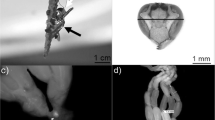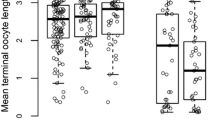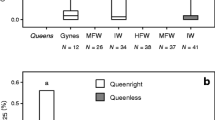Abstract
Eusociality is characterized by a reproductive division of labor, wherein workers respond to the presence of reproductive individuals by refraining from reproduction themselves and restricting the reproductive efforts of others. Our understanding of how eusociality is maintained therefore depends on characterizing the mechanism by which workers detect the presence of a reproductive. Variations in cuticular hydrocarbons correspond to changes in reproductive ability in ants, and experimental studies are beginning to reveal the function of hydrocarbons as signals. In this study, we compare the cuticular hydrocarbon profiles of dominant and reproductive workers and queens of the ant Odontomachus brunneus with profiles of non-reproductive workers. Using split/reunification tests we document the existence of worker policing in both queenless and queenright colonies; supernumerary reproductives were treated aggressively by nestmates. Finally, we induce aggression and replicate queen-like submissive nestmate responses by supplementing the hydrocarbon profile of workers with (Z)-9-nonacosene, a compound that was significantly more abundant on the cuticles of reproductives. In three bioassays, we compare this manipulation to various control manipulations of the hydrocarbon profile and demonstrate that workers gauge the reproductive activity of nestmates through changes in their cuticular hydrocarbon profiles.


Similar content being viewed by others
References
Blomquist GC, Bagnères A-G (2010) Insect hydrocarbons: biology, biochemistry, and chemical ecology. Cambridge University Press, Cambridge
Bos N, Dreier S, Jorgensen CG, Nielsen J, Guerrieri FJ, d'Ettorre P (2012) Learning and perceptual similarity among cuticular hydrocarbons in ants. J Insect Physiol 58:138–146
Bourke AFG (1988) Worker reproduction in the higher eusocial Hymenoptera. Q Rev Biol 63:291–311
Cuvillier-Hot V, Gadagkar R, Peeters C, Cobb M (2002) Regulation of reproduction in a queenless ant: aggression, pheromones and reduction in conflict. Proc R Soc Lond B 269:1295–1300
Cuvillier-Hot V, Lenoir A, Crewe R, Malosse C, Peeters C (2004) Fertility signalling and reproductive skew in queenless ants. Anim Behav 68:1209–1219
Cuvillier-Hot V, Renault V, Peeters C (2005) Rapid modification in the olfactory signal of ants following a change in reproductive status. Naturwissenschaften 92:73–77
Denis D, Chameron S, Costille L, Pocheville A, Chaline N, Fresneau D (2008) Workers agonistic interactions in queenright and queenless nests of a polydomous ant society. Anim Behav 75:791–800
D'Ettorre P, Heinze J (2005) Individual recognition in ant queens. Curr Biol 15:2170–2174
D'Ettorre P, Heinze J, Schulz C, Francke W, Ayasse M (2004) Does she smell like a queen? Chemoreception of a cuticular hydrocarbon signal in the ant Pachycondyla inversa. J Exp Biol 207:1085–1091
Dietemann V, Peeters C, Liebig J, Thivet V, Hölldobler B (2003) Cuticular hydrocarbons mediate discrimination of reproductives and nonreproductives in the ant Myrmecia gulosa. Proc Natl Acad Sci USA 100:10341–10346
Endler A, Liebig J, Schmitt T, Parker JE, Jones GR, Schreier P, Hölldobler B (2004) Surface hydrocarbons of queen eggs regulate worker reproduction in a social insect. Proc Natl Acad Sci USA 101:2945–2950
Foitzik A, Fröba J, Rüger MH, Witte V (2011) Competition over workers: fertility signalling in wingless queens of Hypoponera opacior. Insect Soc 58:271–278
Ginzel MD, Moreira JA, Ray AM, Millar JG, Hanks LM (2006) (Z)-9-nonacosene-major component of the contact sex pheromone of the beetle Megacyllene caryae. J Chem Ecol 32:435–451
Gobin B, Ito F (2003) Sumo wrestling in ants: major workers fight over male production in Acanthomyrmex ferox. Naturwissenschaften 90:318–321
Hart LM, Tschinkel WR (2012) A seasonal natural history of the ant, Odontomachus brunneus. Insect Soc 59:45–54
Heinze J, d'Ettorre P (2009) Honest and dishonest communication in social Hymenoptera. J Exp Biol 212:1775–1779
Heinze J, Oberstadt B (1999) Worker age, size and social status in queenless colonies of the ant Leptothorax gredleri. Anim Behav 58:751–759
Heinze J, Hölldobler B, Peeters C (1994) Conflict and cooperation in ant societies. Naturwissenschaften 81:489–497
Heinze J, Trunzer B, Oliveira PS, Hölldobler B (1996) Regulation of reproduction in the neotropical ponerine ant, Pachycondyla villosa. J Insect Behav 9:441–450
Heinze J, Puchinger W, Hölldobler B (1997) Worker reproduction and social hierarchies in Leptothorax ants. Anim Behav 54:849–864
Heinze J, Stengl B, Sledge MF (2002) Worker rank, reproductive status and cuticular hydrocarbon signature in the ant, Pachycondyla cf. inversa. Behav Ecol Sociobiol 52:59–65
Holman L, Jorgensen CG, Nielsen J, d'Ettorre P (2010) Identification of an ant queen pheromone regulating worker sterility. Proc R Soc B 277:3793–3800
Howard RW, Blomquist GJ (2005) Ecological, behavioral, and biochemical aspects of insect hydrocarbons. Annu Rev Entomol 50:371–393
Izzo A, Wells M, Huang Z, Tibbetts E (2010) Cuticular hydrocarbons correlate with fertility, not dominance, in a paper wasp, Polistes dominulus. Behav Ecol Sociobiol 64:857–864
Keller L, Nonacs P (1993) The role of queen pheromones in social insects—queen control or queen signal. Anim Behav 45:787–794
Kocher SD, Grozinger CM (2011) Cooperation, conflict, and the evolution of queen pheromones. J Chem Ecol 37:1263–1275
Le Conte Y, Hefetz A (2008) Primer pheromones in social Hymenoptera. Annu Rev Entomol 53:523–542
Liebig J (2010) Hydrocarbon profiles indicate fertility and dominance status in ant, bee, and wasp colonies. In: Blomquist GJ, Bagnères A-G (eds) Insect hydrocarbons: biology, biochemistry, and chemical ecology. Cambridge University Press, Cambridge, pp 254–281
Liebig J, Peeters C, Oldham NJ, Markstadter C, Hölldobler B (2000) Are variations in cuticular hydrocarbons of queens and workers a reliable signal of fertility in the ant Harpegnathos saltator? Proc Natl Acad Sci USA 97:4124–4131
Lockey KH (1988) Lipids of the insect cuticle—origin, composition and function. Comp Biochem Physiol B Biochem Mol Biol 89:595–645
Martin S, Drijfhout F (2009a) A review of ant cuticular hydrocarbons. J Chem Ecol 35:1151–1161
Martin SJ, Drijfhout FP (2009b) How reliable is the analysis of complex cuticular hydrocarbon profiles by multivariate statistical methods? J Chem Ecol 35:375–382
Martin SJ, Drijfhout FP (2009c) Nestmate and task cues are influenced and encoded differently within ant cuticular hydrocarbon profiles. J Chem Ecol 35:368–374
Medeiros FLN, Lopes NP, Moutinho PRS, Oliveira PS, Hölldobler B (1992) Functional polygyny, agonistic interactions and reproductive dominance in the neotropical ant Odontomachus chelifer (Hymenoptera, Formicidae, Ponerinae). Ethology 91:134–146
Millar JG (2010) Chemical synthesis of insect cuticular hydrocarbons. In: Blomquist GJ, Bagnères A-G (eds) Insect hydrocarbons: biology, biochemistry, and chemical ecology. Cambridge University Press, Cambridge, pp 163–186
Monnin T (2006) Chemical recognition of reproductive status in social insects. Ann Zool Fenn 43:515–530
Monnin T, Ratnieks FLW (2001) Policing in queenless ponerine ants. Behav Ecol Sociobiol 50:97–108
Nunes TM, Turatti ICC, Lopes NP, Zucchi R (2009) Chemical signals in the stingless bee, Frieseomelitta varia, indicate caste, gender, age, and reproductive status. J Chem Ecol 35:1172–1180
Oliveira PS, Hölldobler B (1990) Dominance orders in the ponerine ant Pachycondyla apicalis (Hymenoptera, Formicidae). Behav Ecol Sociobiol 27:385–393
Peeters C, Monnin T, Malosse C (1999) Cuticular hydrocarbons correlated with reproductive status in a queenless ant. Proc R Soc Lond B 266:1323–1327
Powell S, Tschinkel WR (1999) Ritualized conflict in Odontomachus brunneus and the generation of interaction-based task allocation: a new organizational mechanism in ants. Anim Behav 58:965–972
Ratnieks FLW, Foster KR, Wenseleers T (2006) Conflict resolution in insect societies. Annu Rev Entomol 51:581–608
Seeley TD (1985) Honeybee ecology: a study of adaptation in social life. Princeton University Press, Princeton, New Jersey
Sledge MF, Boscaro F, Turillazzi S (2001) Cuticular hydrocarbons and reproductive status in the social wasp Polistes dominulus. Behav Ecol Sociobiol 49:401–409
Smith AA, Hölldobler B, Liebig J (2008) Hydrocarbon signals explain the pattern of worker and egg policing in the ant Aphaenogaster cockerelli. J Chem Ecol 34:1275–1282
Smith AA, Hölldobler B, Liebig J (2009) Cuticular hydrocarbons reliably identify cheaters and allow enforcement of altruism in a social insect. Curr Biol 19:78–81
Smith AA, Hölldobler B, Liebig J (2011) Reclaiming the crown: queen to worker conflict over reproduction in Aphaenogaster cockerelli. Naturwissenschaften 98:237–240
Smith AA, Hölldobler B, Liebig J (2012) Queen-specific signals and worker punishment in the ant Aphaenogaster cockerelli: the role of the Dufour's gland. Anim Behav 83:587–593
van Walsum E, Gobin B, Ito F, Billen J (1998) Worker reproduction in the ponerine ant Odontomachus simillimus (Hymenoptera: Formicidae). Sociobiology 32:427–440
van Wilgenburg E, Sulc R, Shea KJ, Tsutsui ND (2010) Deciphering the chemical basis of nestmate recognition. J Chem Ecol 36:751–758
van Zweden JS (2010) The evolution of honest queen pheromones in insect societies. Commun Integr Biol 3:50–52
Wilson EO (1971) The Insect Societies. Belknap, Cambridge, MA
Acknowledgments
We thank Walter R. Tschinkel for collection assistance and Fred Larabee for supplying additional colonies.
Author information
Authors and Affiliations
Corresponding author
Additional information
Communicated by J. Heinze
Electronic supplementary material
Below is the link to the electronic supplementary material.
Aggression of nestmate ants of the species Odontomachus brunneus to a newly established reproductive and dominant worker upon reintroduction to her original queenless colony. The ant with a red paint mark on her abdomen is the reintroduced reproductive. The lid of the colony was removed for clarity. Several bouts of rapid antennation can be seen as well as aggression elevating to multiple workers biting, holding, and pulling on the reintroduced worker (WMV 12,575 kb)
Response of nestmate ants of the species Odontomachus brunneus to workers treated with Z9:C29 (with yellow paint mark on thorax). Response by rapid antennation and submissive reactions can be seen multiple times (WMV 4,630 kb)
Rights and permissions
About this article
Cite this article
Smith, A.A., Millar, J.G., Hanks, L.M. et al. Experimental evidence that workers recognize reproductives through cuticular hydrocarbons in the ant Odontomachus brunneus . Behav Ecol Sociobiol 66, 1267–1276 (2012). https://doi.org/10.1007/s00265-012-1380-x
Received:
Revised:
Accepted:
Published:
Issue Date:
DOI: https://doi.org/10.1007/s00265-012-1380-x




